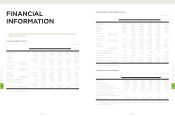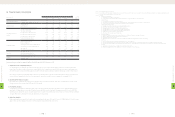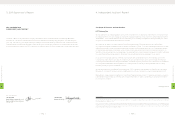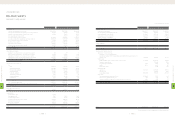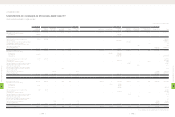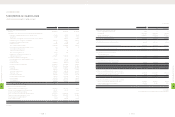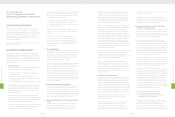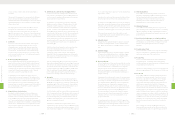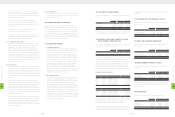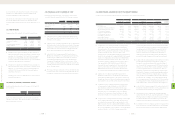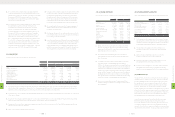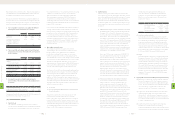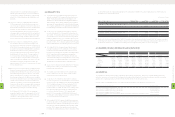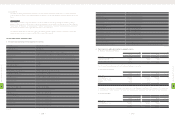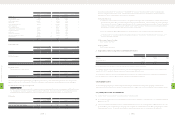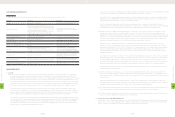HTC 2011 Annual Report Download - page 80
Download and view the complete annual report
Please find page 80 of the 2011 HTC annual report below. You can navigate through the pages in the report by either clicking on the pages listed below, or by using the keyword search tool below to find specific information within the annual report.
(5) CASH AND CASH EQUIVALENTS
Cash and cash equivalents as of December 31, 2010 and 2011 were as
follows:
2010 2011
NT$ NT$ US$ (Note 3)
Cash on hand $1,000 $1,000 $33
Cash in banks 15,491,311 21,852,255 721,697
Time deposits 50,789,765 57,019,065 1,883,122
$66,282,076 $78,872,320 $2,604,852
On time deposits, interest rates ranged from 0.14% to 1.50% and from
0.15% to 1.345%, as of December 31, 2010 and 2011, respectively.
(6) FINANCIAL ASSETS AND LIABILITIES AT FAIR
VALUE THROUGH PROFIT OR LOSS
Financial assets and liabilities at fair value through profit or loss as of
December 31, 2010 and 2011 were as follows:
2010 2011
NT$ NT$ US$ (Note 3)
Derivatives - financial assets
Exchange contracts $450,276 $256,868 $8,483
The Company had derivative transactions in 2010 and 2011 to manage
exposures related to exchange rate fluctuations. However, these
transactions did not meet the criteria for hedge accounting under
Statement of Financial Accounting Standards No. 34 - "Financial
Instruments: Recognition and Measurement." Thus, the Company
had no hedge accounting in 2010 and 2011. Outstanding forward
exchange contracts as of December 31, 2010 and 2011 were as follows:
Forward Exchange Contracts
2010
Buy/Sell Currency Settlement Period/Date Contract Amount
Buy USD/CAD 2011.01.26 USD 250
Buy USD/JPY 2011.01.12∼2011.02.23 USD 18,187
Sell EUR/USD 2011.01.05∼2011.03.18 EUR 531,000
Sell GBP/USD 2011.01.12∼2011.03.25 GBP 57,400
Sell USD/NTD 2011.01.03∼2011.01.31 USD 447,000
2011
Buy/Sell Currency Settlement Period/Date Contract Amount
Buy USD/CAD 2012.01.11∼2012.02.22 USD 28,010
Buy USD/RMB 2012.01.04∼2012.01.31 USD 105,000
Sell EUR/USD 2012.01.04∼2012.03.30 EUR 339,000
Sell GBP/USD 2012.01.11∼2012.02.22 GBP 17,100
Net gain on derivative financial instruments in 2010 was NT$759,889
thousand, including a realized settlement gain of NT$309,613
thousand and a valuation gain of NT$450,276 thousand.
Net gain on derivative financial instruments in 2011 was NT$173,575
thousand (US$5,733 thousand), including a realized settlement loss
of NT$83,293 thousand (US$2,750 thousand) and a valuation gain
of NT$256,868 thousand (US$8,483 thousand). Note 24 has more
information.
(7) AVAILABLE-FOR-SALE FINANCIAL ASSETS
Available-for-sale financial assets as of December 31, 2010 and 2011
were as follows:
2010 2011
NT$ NT$ US$ (Note 3)
Mutual funds $441,948 $736,031 $24,308
Domestic quoted stocks 538 279 9
Less: Current portion (441,948) (736,031) (24,308)
$538 $279 $9
(8) NOTES AND ACCOUNTS RECEIVABLE
Notes and accounts receivable as of December 31, 2010 and 2011
were as follows:
2010 2011
NT$ NT$ US$ (Note 3)
Notes receivable $- $755,450 $24,950
Accounts receivable 36,187,529 32,838,334 1,084,525
Less: Allowance for doubtful accounts
(1,008,491) (1,554,008) (51,323)
$35,179,038 $32,039,776 $1,058,152
(9) OTHER CURRENT FINANCIAL ASSETS
Other current financial assets as of December 31, 2010 and 2011 were
as follows:
2010 2011
NT$ NT$ US$ (Note 3)
Other receivables (Note 25) $677,794 $1,115,915 $36,855
Agency payments 28,610 248,085 8,193
Interest receivables 11,232 19,927 658
$717,636 $1,383,927 $45,706
Other receivables were primarily prepayments on behalf of vendors
or customers, withholding income tax on employees' bonuses, and
other compensation.
(10) INVENTORIES
Inventories as of December 31, 2010 and 2011 were as follows:
2010 2011
NT$ NT$ US$ (Note 3)
Finished goods $809,469 $675,712 $22,316
Work-in-process 5,408,003 7,849,511 259,240
Raw materials 11,272,675 16,788,114 554,448
Goods in transit 4,430,345 75,983 2,509
$21,920,492 $25,389,320 $838,513
in a foreign subsidiary or joint venture and if the temporary
difference is not expected to reverse in the foreseeable future
and will, in effect, exist indefinitely, then a deferred income tax
liability or asset is not recognized.
Tax credits for purchases of machinery, equipment and
technology, research and development expenditures, and
personnel training expenditures are recognized using the flow-
through method.
Adjustments of prior years' tax liabilities are added to or
deducted from the current year's tax provision.
According to the Income Tax Law, an additional tax at 10% of
unappropriated earnings is provided for as income tax in the year
the stockholders approve to retain the earnings.
21. Stock-based Compensation
Employee stock options granted on or after January 1, 2008
are accounted for under Statement of Financial Accounting
Standards No. 39 - "Share-based Payment." Under the
statement, the value of the stock options granted, which is
equal to the best available estimate of the number of stock
options expected to vest multiplied by the grant-date fair value,
is expensed on a straight-line basis over the vesting period,
with a corresponding adjustment to capital surplus - employee
stock options. The estimate is revised if subsequent information
indicates that the number of stock options expected to vest
differs from previous estimates.
22. Treasury Stock
The Company adopted the Statement of Financial Accounting
Standards No. 30 - "Accounting for Treasury Stocks," which
requires the treasury stock held by the Company to be accounted
for by the cost method. The cost of treasury stock is shown as
a deduction to arrive at stockholders' equity, while gain or loss
from selling treasury stock is treated as an adjustment to capital
surplus.
When treasury stocks are sold and the selling price is above
the book value, the difference should be credited to the capital
surplus - treasury stock transactions. If the selling price is below
the book value, the difference should first be offset against
capital surplus from the same class of treasury stock transactions,
and any remainder should be debited to retained earnings. The
carrying value of treasury stocks should be calculated using the
weighted-average method.
When the Company's treasury stock is retired, the treasury stock
account should be credited, and the capital surplus - premium
on stock account and capital stock account should be debited
proportionately according to the share ratio. The difference
should be credited to capital surplus or debited to capital surplus
and/or retained earnings.
23. Reclassifications
Certain 2010 accounts have been reclassified to be consistent
with the presentation of the financial statements as of and for the
year ended December 31, 2011.
(3) TRANSLATION INTO U.S. DOLLARS
The financial statements are stated in New Taiwan dollars. The
translation of the 2011 New Taiwan dollar amounts into U.S. dollar
amounts are included solely for the convenience of readers, using
the noon buying rate of NT$30.279 to US$1.00 quoted by Reuters
on December 31, 2011. The convenience translation should not be
construed as representations that the New Taiwan dollar amounts
have been, could have been, or could in the future be, converted into
U.S. dollars at this or any other exchange rate.
(4) ACCOUNTING CHANGES
1. Financial Instruments
On January 1, 2011, the Company adopted the newly revised
Statement of Financial Accounting Standards (SFAS) No. 34 -
"Financial Instruments: Recognition and Measurement." The
main revisions include (1) finance lease receivables are now
covered by SFAS No. 34; (2) the scope of the applicability of
SFAS No. 34 to insurance contracts is amended; (3) loans and
receivables originated by the Company are now covered by
SFAS No. 34; (4) additional guidelines on impairment testing
of financial assets carried at amortized cost when a debtor
has financial difficulties and the terms of obligations have
been modified; and (5) accounting treatment by a debtor for
modifications in the terms of obligations. This accounting change
had no material effect on the Company's financial statements as
of and for the year ended December 31, 2011.
2. Operating Segments
On January 1, 2011, the Company adopted the newly issued
SFAS No. 41 - "Operating Segments." The requirements of the
statement are based on the information about the components
of the Company that management uses to make decisions
about operating matters. SFAS No. 41 requires identification
of operating segments on the basis of internal reports that are
regularly reviewed by the Company's chief operating decision
maker in order to allocate resources to the segments and assess
their performance. This statement supersedes SFAS No. 20 -
"Segment Reporting." For this accounting change, the Company
restated the segment information as of and for the year ended
December 31, 2010 to conform to the disclosures as of and for
the year ended December 31, 2011.
8
FINANCIAL INFORMATION
| 156 |
8
FINANCIAL INFORMATION
| 157 |


